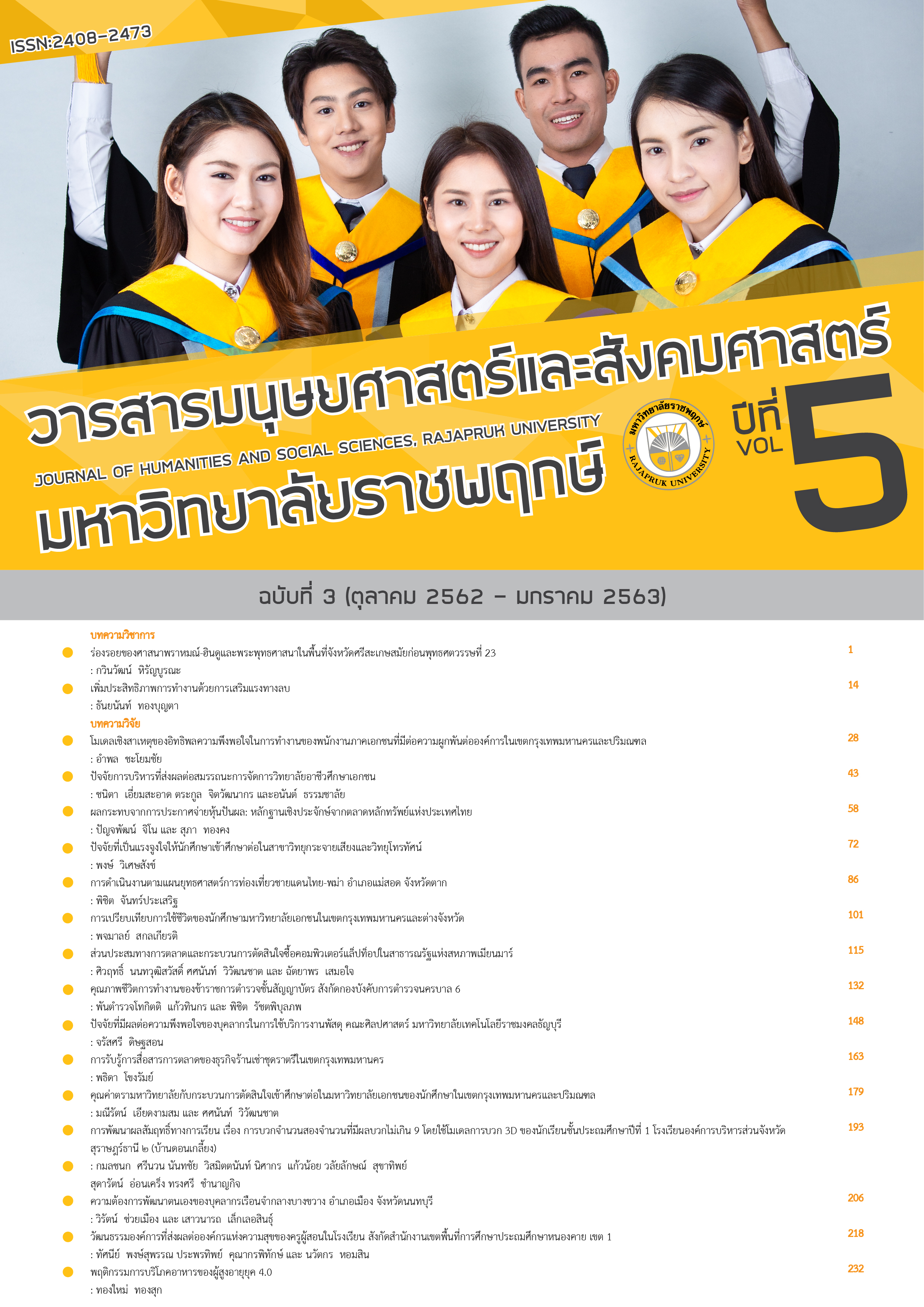โมเดลเชิงสาเหตุของอิทธิพลความพึงพอใจในการทำงานของพนักงานภาคเอกชนที่มีต่อความผูกพันต่อองค์การในเขตกรุงเทพมหานครและปริมณฑล
##plugins.themes.bootstrap3.article.main##
摘要
การวิจัยครั้งนี้มีวัตถุประสงค์เพื่อศึกษาปัจจัยความพึงพอใจในการทำงานที่มีอิทธิพลต่อความผูกพันต่อองค์การของพนักงานภาคเอกชนในกรุงเทพมหานครและปริมณฑล ใช้แบบสอบถามในการเก็บข้อมูลจากตัวอย่าง 400 คน ด้วยวิธีเลือกแบบเจาะจงและสุ่มแบบง่าย วิเคราะห์ข้อมูลโดยใช้สถิติเชิงพรรณนา การวิเคราะห์องค์ประกอบเชิงยืนยันลำดับที่สอง และการวิเคราะห์ตัวแบบสมการโครงสร้าง ผลการวิจัย พบว่า 1) ทั้ง 2 ตัวแปร ได้แก่ ความพึงพอใจในการทำงานและความผูกพันต่อองค์การของพนักงาน มีค่าเฉลี่ยในระดับมาก 2) ความพึงพอใจในการทำงานจากการวิเคราะห์องค์ประกอบเชิงยืนยันลำดับที่สองประกอบด้วยตัวแปรความพึงพอใจด้านองค์การและด้านแรงจูงใจ ส่วนความผูกพันต่อองค์การประกอบด้วย 3 ตัวแปร คือ ความผูกพันด้านเจตคติ ความผูกพันด้านการทำงาน และความผูกพันด้านกฎเกณฑ์ 3) ตัวแบบการวิจัยมีความสอดคล้องกับข้อมูลเชิงประจักษ์ โดยมีค่าสถิติความสอดคล้อง ได้แก่ ค่า Chi-square มีค่าเท่ากับ 122.509 ค่า Chi-square/df เท่ากับ 1.225 ค่า GFI เท่ากับ 0.967 CFI เท่ากับ 0.991 RMR มีค่า 0.046 และ RMSEA มีค่า 0.024 ซึ่งสรุปได้ว่า ตัวแบบสมการโครงสร้างมีความน่าเชื่อถือในการนำไปใช้ประโยชน์ได้ และ 4) ปัจจัยความพึงพอใจในการทำงานมีอิทธิพลเชิงบวกอย่างมีนัยสำคัญต่อความผูกพันต่อองค์การ
##plugins.themes.bootstrap3.article.details##
参考
Abdullah, A. (2011). Evaluation of Allen and Meyer’s organizational commitment scale: A cross-cultural application in Pakistan. Journal of Education and Vocational Research, 1(3) June 2011: 80 - 86.
Akhigbe, O. J., Felix, O. O., and Finelady, A. M. (2014). Employee job satisfaction and organizational commitment in Nigeria manufacturing organizations. European Journal of Business and Management, 6(25): 83 - 95.
Byrne, B. M. (2010). Structural equation modeling with AMOS: Basic concepts, applications, and programming. 2nd ed. New York: Routledge.
Giritli, H., Sertyesilisik, B., and Horman, B. (2013). An investigation into job satisfaction and organizational commitment of construction personnel. Global Advanced Research Journal of Social Science, 2(1) June 2013: 1 - 11.
Hair, J. F., Black, W. C., Babin, B. J., and Anderson, R. E., (2014). Multivaliate data analysis. 7th ed. US: Pearson Education.
Islam, J. N., Mahajan, H. K., and Datta, R. (2012). A study on job satisfaction and morale of commercial banks in Bangladesh. International Journal of Economics and Research, July - August: 152 - 172.
Jaros, S. (2007). Meyer and Allen model of organizational commitment: Measurement issues. The Icfai Journal of Organizational Behavior, 6(4) March 2012: 7 - 25.
Kaplan, M., Ogut, E., Kaplan, A., and Aksay, K. (2012). The relationship between job satisfaction and organizational commitment: The case of hospital employees. World Journal of Management, 4(1) March 2012: 22 - 29.
Mahmud, M. T., Hasan, M. T., and Ashif, A. S. M. (2014). Determinants of job satisfaction: A comparative study in the banking sector of Bangladesh. International Journal of Economics and Empirical Research, 2(1) June 2014: 22 - 28.
Pitaloka, E. and Sofia, I. P. (2014). Antecedent and consequence of internal auditors job satisfaction and organization commitment. Proceeding of Kuala Lumpur International Business, Economics, and Law Conference. Kuala Lumpur: Malaysia.
Priya, N. K. and Sundaram, M. K. (2016). A study on relationship among job satisfaction, organizational commitment and turnover intention in Kolors healthcare India Pvt ltd, Chennai. International Journal of Advanced Research in Management, 7(1) January – April 2016: 58 - 71.
Rahman, M., Uddin, M. J., and Mia, M. A. S. (2012). The Role of Human Resource Management practices on Job Satisfaction and Organizational Commitment in Banking Sector of Bangladesh- A Comparative Analysis. Journal of Faculty of Business Administration, 9(1&2) July 2011 - June 2012.
Tarigan, V. and Ariani, D. W. (2015). Empirical study relations job satisfaction, organizational commitment, and turnover intention. Advances in Management & Applied Economics, 5(2) June 2015: 21 - 42.
Visessombat, T. and Chaiyakul, T. (2019). The effects of motivation, satisfaction and organization commitment to employees’ performance in automotive industry of the eastern seaboard 1 industrial estate, Rayong. Journal of Social Sciences and Humanities, Rajapruk University, 4(3) October 2018 – January 2019: 14 - 26. Retrieved on 16th January 2018, from https://www.tci-thaijo.org/index.php/rpu/article/view/169219/121741 (in Thai)
Weston, R. and Gore, P. A. (2006). A brief guide to structural equation modeling. The Counseling Psychologist, 34(5) September 2006: 719 - 751.
Yucel, I. (2012). Examining the relationship among job satisfaction, organizational commitment, and turnover intention: An empirical study. International Journal of Business and Management, 7(20) October 2012: 44 - 58.

